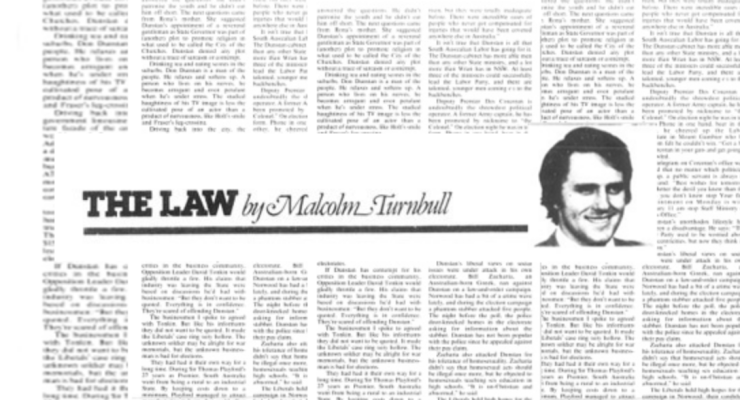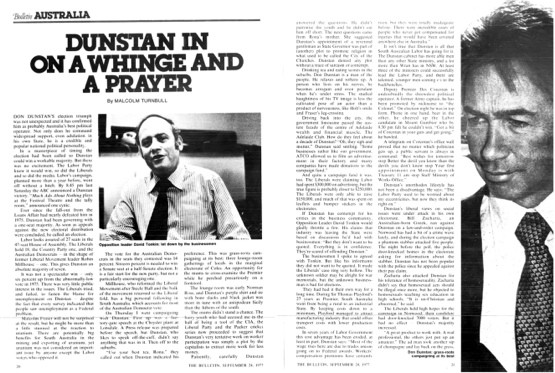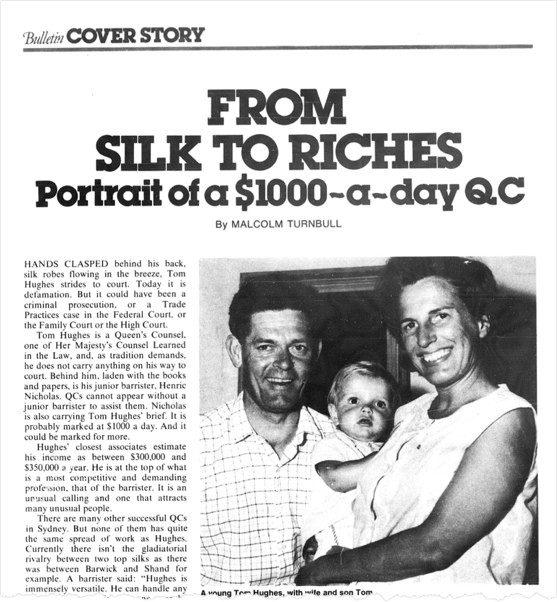
This was originally published October 22, 2015.
In early 1978, a young Malcolm Turnbull, just a year into a short-lived journalism career, met the 20-year-old version of the man he would eventually knife. And his impression was particularly prescient.
Turnbull’s feature on the Australian Union of Students for The Bulletin begins with an anecdote about how vegetarian delegates objected to the use of a fly-swatting machine and ends with an impassioned lament about the impact of student politics on how influential Australians see politicians more broadly. It’s notable for cameo appearances by figures like Michael Danby, Peter Costello, Nick Xenophou (now Xenophon) and Michael Yabsley.
In his book, When We Were Young and Foolish, Australian journalist Greg Sheridan, who was also at The Bulletin, says Turnbull and Abbott got along well at the meeting (“The two had a jovial conversation that was very much a two-way affair rather than an interview”). But the piece Turnbull filed was rather critical — and perhaps a sign of things to come:
“The leading light of the right-wingers in NSW is twenty-year-old Tony Abbott. He has written a number of articles on AUS in the Australian, and his press coverage has accordingly given him a stature his rather boisterous and immature rhetoric doesn’t really deserve.
“Abbott, who is doing second-year economics/law at Sydney University, is the president of the Democratic Club and also controls the Liberal Club, which the Democrats infiltrated and took over a few years ago. He admits his connections with [Bob Santamaria’s National Civic Council] quite openly. ‘Well, the NCC doesn’t have members, you know, but if they did, I’d be one. Our aim is to turn AUS from a political body into a services and education lobby. But I don’t think we will ever get the numbers to do that, so we will have to at least emasculate it as a political body.’
“Abbott was educated at St Ignatius College, in Sydney, and is a practising Catholic. He personifies the political problems of the Democrats. While he can win support from students because of the shocking state of affairs in AUS, he cannot take the next step and take control himself because of his conservative moral views. Abbott is opposed to any legislation of homosexuality and generally presents an old-fashioned DLP image. The students may be more conservative than they were a few years ago, but they have not swung back to the right as much as that.”
(If Abbott did mind what Turnbull wrote about him, he didn’t hold it against the publication. He wrote a piece for The Bulletin himself later that year — his first — and would become a staff journalist for the magazine later on.)
Turnbull’s AUS piece ends thus:
“Everywhere on Australian campuses there is massive distrust and contempt for student politics. Instead of interesting students in politics, the universities are alienating them from it. The student who learns to despise the ranting demogogues on his campus will despise the politicians in Canberra as well. Alienated from politics, he becomes an uninterested cynic and vacates the stage to the ratbags he despises.
“If student political bodies, like the SRCs and AUS, had to compete for student support they would have to prove their worth in the market place. As it is, they are simply expensive playthings for extremist groups who are rightly denied support anywhere else.”
It was one of the bigger articles Turnbull wrote for The Bulletin, which fellow journo Bob Carr used to describe as a “kind of ideological zoo”, according to Sheridan.
“You could run tours, [Carr] suggested, and visitors could feed the different ideological specimens one by one.”
“Seldom can such an astonishing collection have been assembled in a single newsroom.”
Then-journalist Malcolm Turnbull’s own contribution to the zoo was, Sheridan wrote, that of a “polymath, legal scholar, sharp-tongued, occasionally-short of temper, natural genius at business who would almost make Australia a republic”.
Turnbull’s career in journalism started at the Nation Review, where he would write about NSW politics as a third-year law student. His possession of a parliamentary press path allowed him to join radio station 2SM, where he was paid per piece that went to air. A similar arrangement was soon reached with Channel Nine. He then went on holiday to the United States and England and interviewed Rupert Murdoch along the way. Bulletin editor Trevor Kennedy gave him a job in 1977 — his first law column ran in March.
While he would eventually adopt a pseudonym, the Officious Bystander, his column originally ran under his own name. He also penned features and analysis.
These are still available if one bothers to look through the microfilm (the older Bulletin archives are tragically not digitised). The old images reveal, perhaps unsurprisingly, a journalist of some deftness, particularly at such a young age.
He started off straight, with his early pieces fairly factual reports of important legal cases. But, as was encouraged at the time, his writing quickly loosened up.
In the June 4 issue, Turnbull writes on then-NSW premier Neville Wran’s media strategies. There was a belief at the time, Turnbull writes, that Gough Whitlam’s failures had been due to his being too open with the media. Wran attempts to learn from this, Turnbull writes, though his early efforts hadn’t been all that successful.
Turnbull’s prose here is not free from editorialising on the treatment of the NSW press gallery:
“It is horrifying that the Press can be treated like dole recipients, but it is generally true in New South Wales. In Canberra journalists are able to circulate with the public service and extract stories from them. The best journalists in the Canberra gallery operate almost entirely through public service contacts and don’t rely on the ministerial spokesman.”
Speaking further on NSW’s press culture, Turnbull writes that “investigative work, digging around for stories, feature writing are almost all non-existent”.
Much of Turnbull’s early writing deals with proposals of the Law Reform Commission to modernise the law. The body’s recommendations, then headed by Justice Michael Kirby, were closely observed by the young Turnbull. Not that he always agreed with Kirby. Here he is on proposals to protect people from appearing in media if they are in an injured, ill or distressed condition:
“This is quite unworkable. News media have to cover many situations where people are in an injured, ill or distressed condition. Are we to be coddled and protected from tragedy? Will only smiling faces appear on television? Will photographs of disasters have black bars over the faces of the victims, rather like the black bars Sunday papers used to put over ladies’ nipples in a more prudish age? Mr Justice Kirby should not make pain the new obscenity.”
Disagreements aside, Turnbull obviously holds Kirby in high esteem. In July 1977 he conducts a feature-length interview with the man who would become a High Court judge. “Michael Kirby will be prime minister,” it starts, quoting an unnamed politician.
In the December 24 issue (1977), Turnbull declares Kirby the lawyer of the year:
“In the face of considerable criticism from his fellow judges Kirby has mounted the hustings and popularised law reform across the country. For the first time people are beginning to understand that the law is there to serve them and that they have a right to be consulted on reforming it.”
For the most part Turnbull’s writing holds up well. A frequent subject of his column is the the unfair way the legal profession treats women. He covers transgender issues and declares the pointlessness of legislation criminalising marijuana. He also declares his support for a separate Aboriginal legal system:
“The drunken, brawling Aborigines that stagger through the streets of Alice Springs and Oodnadatta are ample testimony to the white man’s failure to administer their lives. As one large drunken black woman yelled obscenities at us across a park I decided the Aborigines could do no worse than us in governing themselves.”
Turnbull’s writing isn’t all serious. His column at times took on a light, playful tone — as often a gossip column as it was a dry lawyerly analysis. Often it was just a collection of things Turnbull liked. Here he is signalling his appreciation for a particularly scathing book review on June 25, 1977:
“There’s nothing the matter with being vicious. In fact there is not nearly enough venom and malice in this meek, pussy-footing society of ours. Lawyers are generally the most at fault. Take Swineface, QC, when he is appearing against his arch foe Wyning-Smythe, QC: ‘As my learned friend would be aware …’ What humbug! He knows full well that his cretinous friend drank his way through law school and would have starved to death if his father hadn’t been the senior partner of a monstrous firm of solicitors.”
On June 18, 1977, he recounts this interaction with a leading QC …
“Sipping a glass of exquisite port with a leading Sydney QC I asked: ‘Really, how can you possibly charge someone $1250 a day for each day you’re in court?’ The learned man winced. ‘Do I really charge that much?’ ‘Indeed you do,’ I replied. ‘A solicitor was complaining of your price only this morning.’ He shrugged the hand-stitched shoulders of his $850 suit. ‘You see, I don’t know how much I actually charge. I find the subject of money so distasteful. I leave it to my clerk to discuss my fees.'”
One would note Turnbull wouldn’t try this excuse when issues of his own wealth came up more recently. And on August 6, 1977, there’s this vignette:
“I was accosted in a hotel the other night by an old friend who told me that a number of judges were furious at their treatment in this column. I have never respected the notion that judges should be treated as though they were a combination of Buddha and a vestal virgin. Their names have been noted and their performances will come under even closer scrutiny.”
This was a theme to which he would return. In a March 7, 1978, opinion piece, “Government by judges endangers justice”, Turnbull rails against the proliferation of judges in decision-making bodies and tribunals.
“The traditional distinctions between executive government, legislature and judiciary have never been as clearly defined in practice as they are in political science textbooks, but now what was once the clearest distinction, that separating the judiciary, is becoming increasingly blurred.”
Two more pieces of writing from 1977 are worth noting. The first is an in-depth feature piece on the election victory of reforming South Australian premier Don Dunstan.
“Don Dunstan’s election triumph was not unexpected and it has confirmed him as probably Australia’s best political operator. Not only does he command widespread support, even adulation, in his own State, he is a credible and popular national political personality.”
Turnbull describes campaigning with Dunstan. Press releases would be prepared before his speeches, but Dunstan wouldn’t say anything that was in them. Turnbull then joined Dunstan in the suburbs as he sat with several women for tea. “Grass-roots campaigning at its best,” Turnbull writes. He also notes Dunstan’s response to a “hairy youth” who accuses the premier of a capitalist ploy. “Patiently, carefully, Dunstan answered the questions. He didn’t patronise the youth and he didn’t cut him off short.”
Don Dustan, who decriminalised homosexuality in South Australia, was gay, but he didn’t speak of it publicly during his premiership. His sexuality was first written of by Adelaide journalists Des Ryan and Mike McEwen in a book they wrote in 1979. Perhaps in a less-than-overt reference to this, Turnbull writes that “Dunstan’s unorthodox lifestyle has not always been a disadvantage”. Dunstan is quoted as saying: ‘The Labor Party used to be worried about my eccentricities, but now they think it’s right on.”
Also in 1977, Turnbull wrote the piece that led to him meeting his future wife, Lucy. He interviewed her father, Tom Hughes QC — Lucy was 19 years old and working in her father’s office at the time. She is only fleetingly mentioned in Turnbull’s article:
“He has three children, Lucy 19, Tom 15 and Michael 13. Lucy has just finished first-year law and is still considering whether to follow her father’s footsteps at the bar or branch out into the solicitor’s side of the profession.”
Turnbull would continue to write for the magazine for much of 1978, including his fantastic AUS feature, but his contributions had waned by the end. In his “The Law with Malcolm Turnbull” column of August 15 he reveals why.
“I am departing this fair land for studies at Oxford courtesy of Cecil Rhodes and, it being hard enough to get a good oil when you’re three blocks from the Supreme Court, it is doubtless impossible when the intervening gap stretches to a couple of continents …”
Turnbull would of course continue writing and freelancing for a range of publications, including The Bulletin, for some years yet. Crikey will have the second part of his journalistic career highlights next week.
*Additional reporting by Crikey intern Mark Kearney











An interesting dig into Turnbull’s publications. Looking forward to the second part.
I wonder how Malcolm and Wayne Martin now the chief justice of Western Australia get along after Martin then in the role of counsel to the HIH royal commission recommended that an adverse finding be made against Turnbull..the commissioner declined to do so..surprise surprise..
Wot Zut sed – quite fascinating “Portrait of the (B/S) Artist as a Young Man”.
Look forward to the next – hopefully not injuncted. (you are based, after all, in Mexico – see yesterday’s article).
Lawyer, journalist and politician.
He is clearly an interesting person, it will be interesting to see who much he is willing to prostitute himself to keep power.